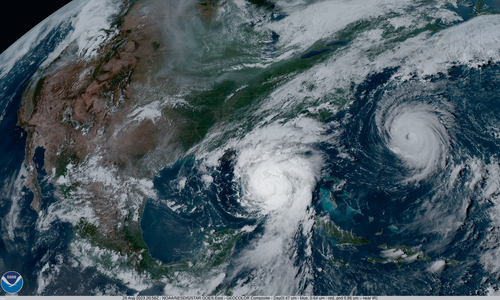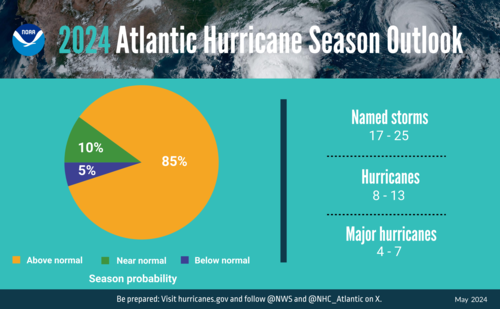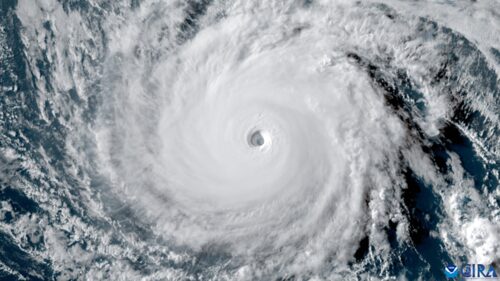2024 Hurricane Season: NOAA Releases Forecasts for Atlantic and Central Pacific
NOAA National Weather Service forecasters at the Climate Prediction Center have released their predictions for the 2024 season and are expecting above-normal hurricane activity in the Atlantic basin and below-normal activity in the Central Pacific.
Published 6 months ago
Above Normal Atlantic Hurricane Season
NOAA’s outlook for the 2024 Atlantic hurricane season, which spans from June 1 to November 30, predicts an 85% chance of an above-normal season, a 10% chance of a near-normal season and a 5% chance of a below-normal season.
NOAA is forecasting a range of 17 to 25 total named storms (winds of 39 mph or higher). Of those, 8 to 13 are forecast to become hurricanes (winds of 74 mph or higher), including 4 to 7 major hurricanes (category 3, 4 or 5; with winds of 111 mph or higher). Forecasters have a 70% confidence in these ranges.


La Nina conducive to Atlantic hurricane activity
The upcoming Atlantic hurricane season is expected to have above-normal activity due to a confluence of factors, including near-record warm ocean temperatures in the Atlantic Ocean, development of La Nina conditions in the Pacific, reduced Atlantic trade winds and less wind shear, all of which tend to favor tropical storm formation.
As one of the strongest El Ninos ever observed nears its end, NOAA scientists predict a quick transition to La Nina conditions, which are conducive to Atlantic hurricane activity because La Nina tends to lessen wind shear in the tropics. At the same time, abundant oceanic heat content in the tropical Atlantic Ocean and Caribbean Sea creates more energy to fuel storm development.
This hurricane season also features the potential for an above-normal west African monsoon, which can produce African easterly waves that see some of the strongest and longer-lived Atlantic storms.
Finally, light trade winds allow hurricanes to grow in strength without the disruption of strong wind shear, and also minimize ocean cooling.
Human-caused climate change is warming our ocean globally and in the Atlantic basin, and melting ice on land, leading to sea level rise, which increases the risk of storm surge. Sea level rise represents a clear human influence on the damage potential from a given hurricane.


Below Normal 2024 Central Pacific Hurricane Season
The 2024 central Pacific hurricane season outlook from forecasters at NOAA’s Central Pacific Hurricane Center and NOAA’s Climate Prediction Center, calls for 1–4 tropical cyclones across the central Pacific Hurricane region. A near-normal season has 4 or 5 tropical cyclones, which include tropical depressions, tropical storms and hurricanes.
Overall, there is a 50% chance of below-normal tropical cyclone activity. The outlook also indicates a 30% chance of a near-normal season and 20% for an above-normal hurricane season across the central Pacific hurricane region. The central Pacific hurricane region is located north of the equator between 140°W and the International Date Line.


“Hurricane season in the central Pacific region is likely to be below average this year,” said Matthew Rosencrans, lead seasonal hurricane forecaster at NOAA’s Climate Prediction Center, a division of NOAA’s National Weather Service (NWS). “A key factor influencing our forecast is the predicted arrival of La Nina this summer, which typically contributes to less tropical cyclone activity across the central Pacific Ocean basin.”
As one of the strongest observed El Ninos nears its end, NOAA scientists predict a quick transition to La Nina conditions. La Nina typically increases wind shear in the central Pacific region, making it harder for storms to develop. Forecasters look at a combination of atmospheric and oceanic conditions, climate patterns and climate models to develop the outlook.
………………………………
Related News:
- Atlantic Weather 2024: Scientists Predict Very Active Hurricane Season (Noonsite April 2024)
- Colorado State University Hurricane Season Forecast 2024
- Yale Climate Connections Predicts Extremely Active 2024 Atlantic Hurricane Season
- Accuweather experts warn of explosive 2024 Hurricane Season
………………………………
Related Links:
- Noonsite Cruising Resources: Weather
- Colorado State University Seasonal Hurricane Forecasting
- Yale Climate Connections
- Accuweather
- NOAA Central Pacific Hurricane Center
- NOAA Climate Prediction Centre
………………………………
Noonsite has not independently verified this information.
………………………………
Find out all news, reports, links and comments posted on Noonsite, plus cruising information from around the world, by subscribing to our FREE monthly newsletter. Go to https://www.noonsite.com/newsletter/.
Related to following destinations: Abaco Islands, Acapulco, Acklins Island, Alice Town, Alice Town (North Bimini), Ambergris Cay, Amelia Island, Andros, Anegada, Anse Marcel, Anse Mitan, Antigua, Antigua & Barbuda, Aruba, Baha Tortugas (Turtle Bay), Bahamas, Baja Asuncion, Baracoa, Barahona, Barbados, Barbers Point Harbour (Ko Olina), Barbuda, Barcadera, Basse Terre, Basseterre, Beef Island, Belize, Belize City, Bequia, Bermuda, Berry Islands, Big Creek (Placencia), Bimini Islands, Black Sound (Green Turtle Cay), Blue Lagoon, Boca Chica, Bonaire, Bowden Harbour/Port Morant, Bradenton, Bridgetown, Britannia Bay - Lovell, British Virgin Islands, Cabo San Lucas, Canouan, Cap Haitien / Labadie, Cap Mole St. Nicolas, Cape Canaveral, Cape Eleuthera, Cape Santa Maria, Carrabelle / Apalachicola, Casa de Campo, Casilda (Trinidad), Castries, Cat Cay, Cat Island, Caye Caulker, Cayman Brac, Cayman Brac (Creek), Cayman Islands, Cayo Coco-Guillermo, Cedros Island, Chaguaramas, Charlestown, Charlotte Amalie (St Thomas), Charlotteville, Chateaubelair, Christiansted (St. Croix), Chub Cay, Cienfuegos, Ciudad Lazaro Cardenas, Clarence Town, Clarkes Court Bay, Codrington, Compass Cay, Conception Island, Conception Island Port, Congo Town (South Andros), Cooper Island, Coopers Town (Abaco), Coral Bay (St. John), Corpus Christi, Crabbs Peninsula, Crooked Island, Crooked Island District, Cruz Bay (St. John), Cuba, Curacao, Daytona Beach, Deshaies, Destin / Fort Walton, Dominica, Dominican Republic, East Coast (USA), El Colony, Elbow Cay, Eleuthera, English Harbour, Ensenada, Exuma, Falmouth Harbour, Florida, Fort Bay (Fort Baai), Fort Lauderdale, Fort Myers, Fort Pierce, Fort-de-France, Fox Town (Little Abaco Island), Frazer's Hog Cay, Freeport (Bahamas), Freeport (Texas), Fresh Creek (North Andros), George Town, Governors Harbour, Grand Bahama Island, Grand Cay (Little Grand Cay), Grand Cayman, Grand Turk (Cockburn Town), Great Abaco Island, Great Exuma: George Town, Great Guana Cay, Great Harbour, Great Harbour Cay, Great Inagua, Grenada, Grenville, Guadeloupe, Guana Cay, Guaymas, Gulf Coast, Gun Creek (Virgin Gorda), Gustavia, Haiti, Haleiwa, Half Moon Cay, Hamilton - Bermuda, Hana Bay, Hanalei Bay, Harbour Island, Havre de la Trinite, Havre du Robert, Hawaii, Hawaii (Big Island), Hawks Nest (Cat Island), Hemingway Marina (Havana), Highborne Cay, Hilo, Hog Island, Honokohau (Kailua-Kona), Honolulu, Hope Town (Elbow Cay), Houston/Galveston, Huatulco (La Crucecita), Iles des Saintes, Ireland Island (Sandys Parish), Isla de la Juventud, Jacksonville, Jamaica, Jolly Harbour, Jost van Dyke, Jupiter, Kahului, Kaneohe, Kauai, Kaunakakai, Kawaihae, Key Biscayne, Key Largo, Key West, Kikiaola, Kingston, Kingstown, Kralendijk, La Cruz de Huanacaxtle, La Paz, Lahaina, Lanai, Las Salinas, Les Anses d'Arlet, Line Islands, Little Cayman, Little Cayman (Port), Little Farmer's Cay, Little San Salvador (Half Moon Cay), Long Island, Loreto, Luperon, Lyford Cay, Maalaea, Man-O-War Cay, Manele, Manzanillo, Manzanillo, Marathon, Maria La Gorda, Marie Galante, Marigot, Marigot Bay (St. Lucia), Marigot Bay (St. Martin), Marin, Marina Cayo Largo, Marina Los Morros, Marsh Harbour (Great Abaco Island), Martinique, Matagorda, Matthew Town, Maui, Mayaguana, Mayaguana Port, Mayreau, Mazatlan, Melbourne (Florida), Mero, Mexico, Miami, Middle Caicos, Mississippi, Molokai, Monte Cristi, Montego Bay, Morgans Bluff (North Andros), Mt Hartman Bay, Mustique, Nanny Cay, Naples (Florida), Nassau, Nature Coast, Nawiliwili, Nevis, New Orleans, New Plymouth (Green Turtle Cay), New Providence, Norman Island, Norman's Cay, North Caicos, Oahu, Ocho Rios, Oracabessa, Oranjestad, Other Islands (BVI), Ottley Hall, Out Islands, Oyster Pond, Oyster Pond, Palmyra Atoll, Panama City, Parham Town, Pearl Harbor, Pensacola, Peter Island, Petit Martinique, Philipsburg, Pointe-a-Pitre, Port Allen, Port Antonio, Port Egmont (Le Phare Bleu Bay), Port Elizabeth (Bequia), Port Howe, Port Louis (Guadeloupe), Port Lucaya, Port Morgan (Ile-a-Vache), Port of Spain, Port St. Charles, Port-au-Prince, Portsmouth, Prickly Bay, Puerto Angel, Puerto Chiapas, Puerto de la Navidad, Puerto de Vita, Puerto Escondido Baja, Puerto Penasco (Rocky Point), Puerto Plata (Cofresi), Puerto Vallarta, Pukoo Harbour, Punta Cana, Punta de Mita, Punta Gorda, Red Hook: Vessup/ Muller Bay, Road Harbour, Rock Sound, Rodney Bay, Roseau, Rum Cay, Saba, Saint Francois, Salina Cruz, Samana, Sampson Cay, San Blas, San Carlos, San Pedro (Ambergris Cay), San Salvador, Santa Lucia, Santa Rosalia, Santiago de Cuba, Santo Domingo, Sapodilla Lagoon, Sarasota, Sauteurs, Scarborough (Tobago), Schooner Bay (Great Abaco Island), Simpson Bay, Sint Maarten, Soufriere, South Bimini, South Caicos, South Padre Island, Spanish Cay, Spanish Town (Virgin Gorda Yacht Harbour), Spanish Water, Spanish Wells, St Kitts, St Pierre (Martinique), St. Augustine, St. Barts, St. Croix, St. Davids, St. George's, St. George's Harbour, St. John, St. John's, St. Kitts & Nevis, St. Lucia, St. Martin, St. Petersburg / Tampa Bay, St. Thomas, St. Vincent, St. Vincent & the Grenadines, Staniel Cay, Statia, Store Bay, Stuart / St. Lucie, Tarpon Springs, The Grenadines, Thompson Bay, Tobago, Tobago Cays, Topolobampo, Tortola, Treasure Cay, Trinidad, Trinidad & Tobago, Trois Ilets, True Blue Bay, Turks & Caicos, Tyrell Bay & Hillsborough (Carriacou), Union Island, US Virgin Islands, USA, Varadero, Venice, Vieux Fort, Virgin Gorda, Virgin Islands National Park, Waianae Harbour, Walker's Cay, Wallilabou Bay, Warderick Wells, Well's and Ladder Bays, West Caicos, West Coast (Mexico), West End, West End (Sopers Hole), West Palm Beach, White Sound (Green Turtle Cay), Willemstad, Young Island Cut, Zihuatenejo
Related to the following Cruising Resources: Atlantic Crossing, Atlantic Ocean East, Atlantic Ocean South, Atlantic Ocean West, Forecast Services, Hurricanes and Tropical Cyclones, Pacific Crossing, Pacific Ocean East, Pacific Ocean North, Pacific Ocean South, Pacific Ocean West, Routing, Weather








